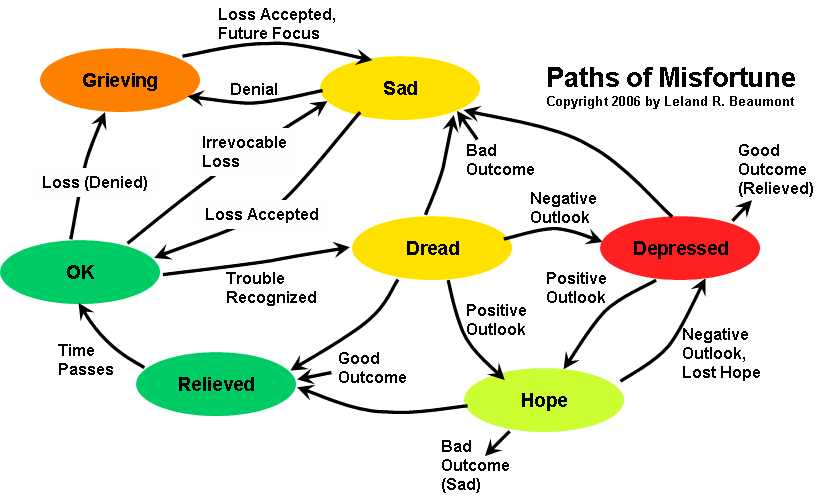A goal is frustrated and you feel distress. When this frustration has changed for the better, and you learn that what you dreaded will not happen, you feel relief. Everything is now much better, you relax and feel a sigh of relief.
Definitions
- Frustration has changed for the better
- Anticipated undesirable outcome has not occurred
Root: Old French relief, derivative of relever to raise.
Paths of Relief
Events that can trigger our relief are common occurrences. How we respond to the dread that precedes relief and the choices we make affect our peace of mind, well being, and our lives. The following figure illustrates choices we have and paths we can take to either prolong or resolve our sadness. Use this like you would any other map: 1) decide where you are now, 2) decide where you want to go, 3) choose the best path to get there, and 4) go down the chosen path.
You may wish to print out this one-page version of the Paths of Misfortune map.

This diagram is an example of a type of chart known by systems analysts as a state transition diagram. Each colored elliptical bubble represents a state of being that represents the way you are now. The labels on the arrows represent actions or events and the arrows show paths into or out of each state. You are at one place on this chart for one particular interaction at any particular time. Other people are likely to be in other places on the chart. This is similar to an ordinary road map where you plot where you are now, while other people are at other places on the same map. Begin the analysis at the green “OK” bubble, or wherever else you believe you are now.
OK: This is the beginning or neutral state. It corresponds to someone who is feeling well. The green color represents safety, tranquility, equanimity, and growth potential.
Irrevocable loss: You recognize you have lost something valuable and that it is gone forever. You are sad.
Sad: You recognize an irrevocable loss. Perhaps you are crying or tearful. The yellow color represents the loss and pain.
Loss Accepted: When you can turn your thoughts to the future and leave the past behind, you have accepted the loss and can get on with your life.
Loss Denied: Protesting, denying, bargaining, and reliving the past all serve to deny the loss. You are living in the past and not ready to accept the loss. Grieving will continue.
Grieving: Grieving is the struggle to prevent the loss. It is our way of coping with loss and it may involve anger, anxiety, anguish, hope, or guilt. Once the protest and denial is over and the loss is accepted as irrevocable, then grief can turn into sadness and be resolved. Our focus shifts from the past to the future during bereavement. The orange color represents the agony, pain, duration, turmoil, and loss of the grieving period.
Loss Accepted, Future focus: You have decided it is time to get over it, accept the loss, and get on with your life.
Trouble Recognized: You become aware that you can lose something you value. You are worried and dread the possible loss.
Dread: You feel bad because you understand you may lose something. Depending on what it is you stand to lose, you may feel anxious, fear, anger, shame, guilt, envy, or jealousy. The yellow color represents the loss, anxiety, and uncertainty of the time.
Positive Outlook: Although you recognize a bad outcome is possible, you predict a favorable outcome and maintain hope.
Hope: You believe with all the depths of your being that things will get better. You have hope; and you are doing things to improve your future. You are fearing the worst but expecting the best. Hope is the antidote to the hopelessness of despair. The green color represents the positive outlook, while the yellow color represents the uncertainty and possible bad outcome.
Negative Outlook: You predict the worst, and you have lost hope. You become depressed.
Depression: You have lost hope, the future looks bleak, you are depressed and feel hopeless. The red color represents the prolonged pain of the depression.
Good Outcome: Regardless if you were dreading, hoping, or depressed, you were spared your worst fears and the actual outcome is good. You are relieved.
Relieved: The frustration has changed for the better, and you learn that what you dreaded will not happen, you feel relief. Everything is now much better, you relax and feel a sigh of relief. The green color represents the good outcome and buoyancy of the relief.
Time Passes: The sensation of relief is rather brief. Soon you are back to your ordinary self, looking toward the future.
Bad Outcome: Your fears have come true. Regardless if you were dreading, hoping, or depressed, the actual outcome is bad, and now you are sad.
References
[laz] Passion and Reason: Making Sense of Our Emotions by Richard S. Lazarus, Bernice N. Lazarus
[Ekm] Emotions Revealed : Recognizing Faces and Feelings to Improve Communication and Emotional Life by Paul Ekman
[OCC] The Cognitive Structure of Emotions by Andrew Ortony, Gerald L. Clore, Allan Collins
[Gol] Destructive Emotions : A Scientific Dialogue with the Dalai Lama by Daniel Goleman
|
